 THE LANDSCAPE PAINTER’S WORKBOOK:
THE LANDSCAPE PAINTER’S WORKBOOK:Order now
U.S.: Amazon | B&N | Book-a-Million | IndieBound | Bookshop.org
United Kingdom: Amazon | Waterstones | Book Depository | Books etc. | Bookshop.org
Canada: Amazon | Indigo
Australia: Booktopia
Watch the13-minute video introduction: Understanding Composition through Shape and Notan
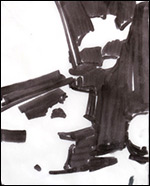 Every composition is fundamentally an arrangement of simple abstract shapes. If a painter wishes to become a true “composer” — who can wield compositional energies as readily as he wields the brush — then he must first become a master of shape recognition. The notan is a type of study the is ideally suited to finding the shapes and patterns that serve as the foundation of every composition.
Every composition is fundamentally an arrangement of simple abstract shapes. If a painter wishes to become a true “composer” — who can wield compositional energies as readily as he wields the brush — then he must first become a master of shape recognition. The notan is a type of study the is ideally suited to finding the shapes and patterns that serve as the foundation of every composition.
Notan is a Japanese word that means “light-dark balance.” A notan uses an extremely limited range of values: in its most strict form, just black and white; in its more liberal form, black, white, and a mid-tone. This flat and abstract design notation is uniquely suited for expressing a composition in its irreducible shape-terms. The power of notan is that when a design is expressed in such simplified terms, compositional energies like dominance and recessiveness, weight, movement, and balance become easier to see. (The examples in this article all demonstrate the strict 2-value form of notan.)
Why is a study that helps us identify shapes so important? Because the underlying shapes that define a composition are not always obvious. When developing a composition from life — be it a landscape, a still life, or a figure — we are confronted with a lot of information: elements of all shapes and sizes, innumerable gradations of tone and color, and an abundance of detail. All this has bearing on our final painting — but it is also quite distracting. The core shapes and patterns that underly the composition are often masked. A notan drills down beneath the “surface story” to make the invisible visible. Like the sculptor who must visualize the final form embedded within the stone before he begins, so too must the painter be able to find the core structure of their composition amidst all the distracting tone, color, and detail.
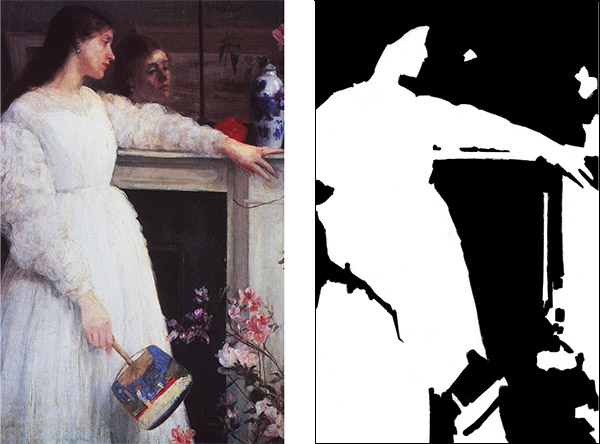
James McNeill Whistler, 1864, Symphony in White No. 2: The Little White Girl, oil on canvas. In Whistler’s Symphony, the inherent contrast between the white dress and the darker background forms a very apparent notan structure. (This notan was “reverse-engineered” by tracing a reproduction of the painting with a black marker.) The overall shape of the girl beautifully interrupts the dark background. The horizontal and vertical energies, formed by the reverse L-shape of the girl and her arm, form upper and lower dark sections. A circular path is created within the white channels, which helps move the eye through the composition. With just a few major shapes, Whistler’s painting allows our eye to travel through an extremely unified composition.
A shape- and pattern-defining tool
When painters first see a notan study, they often incorrectly identify it as a two-value study. A notan, however, is not a value study in the traditional sense. A value study attempts to to map the range of values we see in the usbject. But a notan, with just two or three values, doesn’t have enough vlaue range to do this. What it can do very well is define the patterns and shapes that form the basis of the composition, which is what makes it such a powerful compositional aid. As Barry John Raybould of Virtual Art Academy explains, “A notan is not the value structure of the painting — it is the framework for that value structure.”
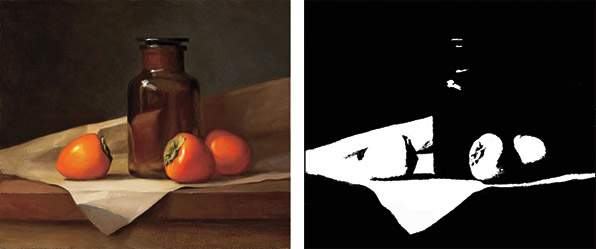
David Dwyer, Persimmons, 2013, oil on canvas, 12 x 14 in. Persimmons is painted in the classic tradition, relying on carefully modulated tones and strong contrasts between light and dark. In paintings like this, the patterns of light and shadow will correspond closely to the pattern of white and black of the notan. Yet there are still several areas of mid-tones that must be resolved in the notan study. Deciding whether they will be assigned to white areas or black areas is at the heart of the notan design process. The mid-tones on the left side of the cloth fall to white, while those on the right fall to black. That choice reveals the diagonal movement of the composition, which hinges on the shape of the cloth. What makes Dwyer’s composition successful is not simply his facility in observing patterns of light and shadow, but his ability to arrange those patterns in a way that creates simplicity, balance, cohesion, and movement.
The soul of a painting
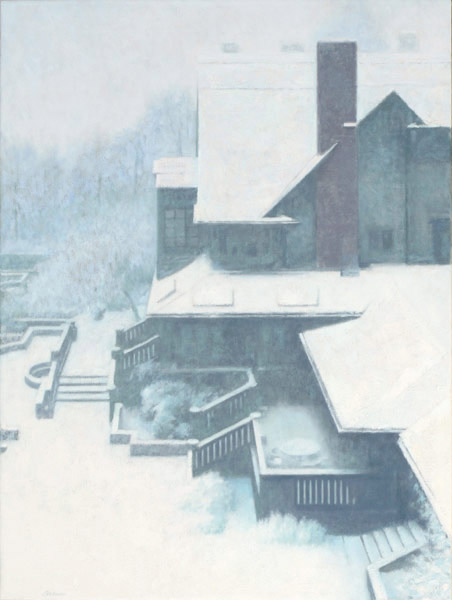
Mitchell Albala, Garden Steps in Winter, 2012, oil on canvas, 28 x 21 in. A notan design can be so strong that it becomes the very subject of the painting. Here, the composition meets several tenets of good notan design: the eye is able to take in the entire composition at once; smaller or recessive shapes do not distract from the primary ones; the darks and lights are not used in equal measure; there are a limited number of major shapes; and the “negative” shapes are just as interesting as the “positive” ones.
As you begin to look at paintings and drawings through the lens of notan design, you will discover that the most powerful compositions often have a strong notan structure at their core. Interestingly, you will also notice that many great paintings are not built upon a solid notan design. Does this mean that those paintings did not have good compositions? Not necessarily. Art and design are far too diversified for any single theory to cover all compositional situations. However, a painting that does have a beautiful notan design at its core has a far better chance of being a stronger and more enduring composition.
The notan is the single most direct method I have found to gain access to the invisible energies that animate a composition. If a composition has a soul, then the notan is the doorway to that soul. Fortunately, the qualities of an effective notan are the very same as those of an effective composition. They are inseparable. Learning to work with the notan teaches us to be better “composers.”
The notan in action
How can notan theory be practically implemented? When perceived through the lens of notan, a subject is becomes a collection of light and dark shapes. Finding the most effective composition, then, is largely a matter of considering different arrangements of these shapes. How much “white” real estate is given to this area? How much “black” real estate is given to that area?
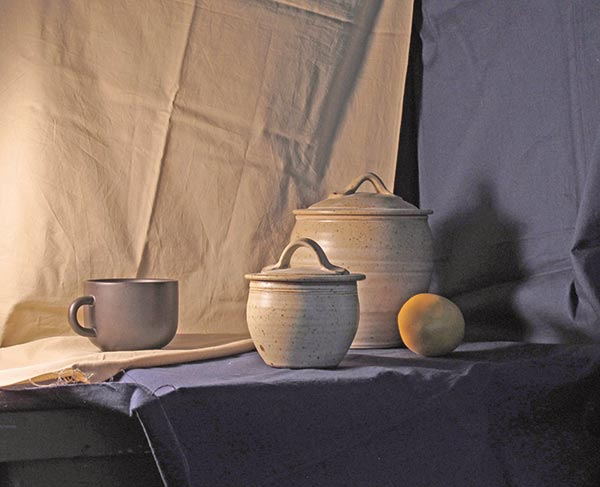
The original subject has a lot of potential: the color and tonal contrast between the beige cloth and the blue background cloth; the interesting shadow patterns on the cloth; and the alternating patterns of light and shadow among the jugs and fruit. However, there are too many objects and too much background. In my notan studies, I’ll eliminate the cup and reduce the amount of area I devote to the background.
Each of the notan studies below takes a slightly different viewpoint or “cropping.” This is a very important aspect of notan design (or any kind of compositional study), because it is one of the main ways we decide which shapes will be part of the composition and which will not. It can also help simplify the design. These three views are not so different from what you might find when looking through your viewfinder or cropping device, except here the notan’s graphic style makes the shapes even more apparent. Also note that the areas assigned to black and the areas assigned to white are not the same in each study. The notan isn’t just about which shapes are included, but the shape of those shapes, as determined by whether mid-tones will fall to white or black.

A. The dark shadow to the right of the large jug is an interesting shape. To “test” it in the composition, I allow the blue cloth around the shadow to fall to white. It’s a good first attempt, but the composition feels too centered. The vertical shadow on the background cloth is also conspicuously centered. This version has less movement than will I find in the other two studies.
B. Now the group of objects sits more to the right with more open space to the left. This adds some asymmetry and more interest. I consider how color may be applied to these shapes in the painting. Maybe all the warm light coming in from the left can be an entry into the painting. I try to express that in the notan with a large white area. The dark shadow to the right of the jug, noted in A, is now one dark area of cloth. It serves as a counterpoint to the white area on the left.
C. The diagonal shadows on the beige cloth form patterns that add movement to the design and activate the “empty” area of cloth. A vertical orientation helps draw attention to this. The diagonal shadow is a mid-tone and is quite thick, but I make it thinner here to give the shadows less visual density. The overall movement and balance between light and dark makes this version most satisfying to me.
Additional Resources
Video Lesson: Notan – Exploring Shape and Composition
The Landscape Painter’s Workbook: Essential Studies in Shape, Composition, and Color, Chapter 4: Notan and the Compositional Study

12 Comments
I have your book and this is one of the most interesting and helpful topics I found in it. Congratulations and thank you for sharing.
As a self-taught artist, I found this notan lesson clearly explained and very informative. The information also encourages me to do a better job of seeing different options for my composition and to do a better job organizing my painting plans before I begin my still life or landscape. I really find your book very helpful, and thanks for this preview.
Mitch,
This is a lovely presentation. First the photo choice with all the value gradations, the kind of thing that makes someone like me worry about making the “correct” notan choices, a concern that has made me think of the process as difficult. Look at the the lids; one is clearly light and one is dark, but you have done both dark. The fruit has only tiny rim light, but you have stated strong light for almost half of it. Why you are doing what you are doing becomes clear as one judges desirability of the choices comparing strength of different compositions, a relatively easy step! This demo has helped me internalize that one should quickly choose the first light and dark Notan pattern without concern as to “correctness” because the objective of that first assessment is only to create a starting point from which to assess how the composition might be improved.
Your video gives neat examples of how easy it is to see the need for subsequent adjustment when the first cut makes an area dark that would be better light or vice versa.
Gerry
Sounds like you’re getting it, Gerry. Keen observations, as always. The biggest obstacle to representational painters is representation itself. The “eyelids” or the “rim light” of the fruit are subordinate parts. The notan tries to get at the over-arching framework onto which the eyelids and rim lights may be attached. Notan supports the grandest philosophy in painting: that the the general precedes the specific — always.
Dorothy, I’m glad you are starting to “think in notan.” I am a big advocate of better planning and organizing in the formative stages of a painting. This can help you avoid many troubles later on. The notan is most certainly a “formative” design tool, as it’s most useful int he early stages, as show in the demonstration at the end of the post.
Great demonstration. I have your book and really enjoy reading different parts. I am just starting a new painting, where the customer has send me some reference photos of the landscape they want me to paint. In order to get the best composition I will make notan to start. I have always jumped right into painting, but this time I will plan more carefully — I think it saves time in the other end.
Glad to see that you are trying out the notan, Sisse. If it gets you to do a little more planing up front, then it’s doing it’s job. Strip the composition down to its bare bones (which can also be done with a 3-value notan, which the article did not cover. Black, white and a middle gray). Client photos can sometime be problematic, because they are only focused on the narrative, whereas you, as the artist, would likely look for other ingredients in the photo that will ld help form a good composition — like differentiation of shapes, good light and shadow structure, good colors, etc. Good luck. Be notanified!
Very well thought out presentation… I had heard of notan design before in school but we never went into this much depth. Find it really interesting! I can really focus on changing the composition of my paintings because of your detailed post. Usually when I paint I just choose an image I find appealing and go ahead and paint it… but after viewing your presentation I know now that I should plan and organize my subject before diving into a painting. As a self-taught painter I never really worried too much about making a piece more dramatic and intriguing with the correct lighting and shades through notan. Thank you so much for inspiring me to focus on the composition of paintings more!
Good to hear, Amina. It sounds like you are getting the notan in a big way. If you’re exploring your compositions in more depth before you start painting, then you’ve understood the most important lesson. Congrats!
After reading this article, doing some Notan exercises and taking a class with Mitch my work has improved. in thr last month six paintings have been accepted into juried shows and I have a betyer sensitivity towards good composition thanks to Mitch. I recommend his book and teaching.
After reading this article, doing some notan exercises, and taking a workshop with Mitch, my work has improved dramatically. Just in the last month, six paintings have been accepted into juried shows at the Federation of Canadian Artists. I feel that I have a better sensitivity towards good composition and colour thanks to Mitch. I recommend his book and teaching.
Thanks, Jane. I’m always especially pleased when someone sees improvement in their work through the use of notan. The notan is such an under-utilized tool, and taught so little, but when someone gets it, they usually get it in a big way. Keep up the good work.